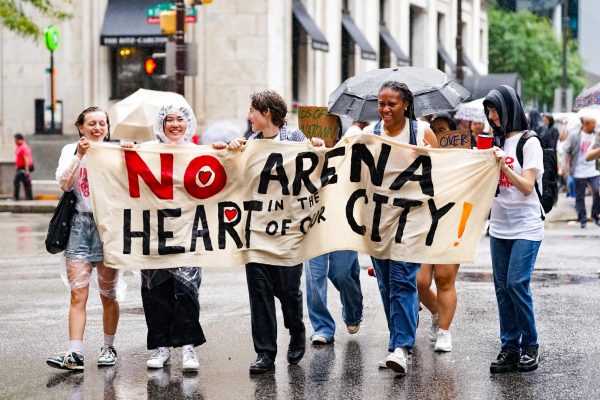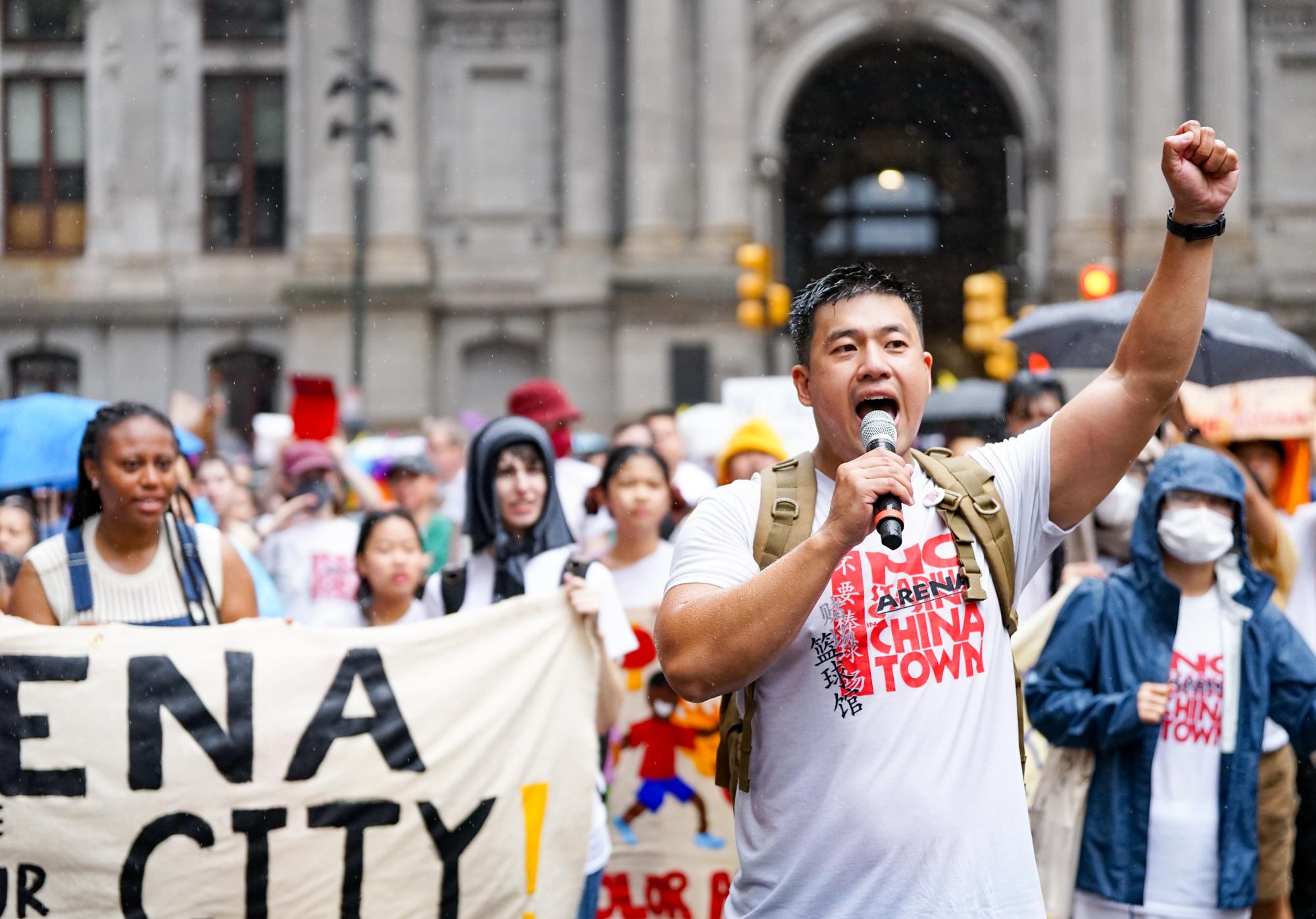Story by Eshan Singh and Faith Zantua, Co-Copy Editor and Co-News Editor
Package by Riddima Pandey, Co-Multimedia Editor
From eating at local restaurants and attending cultural festivals to visiting family and meeting friends, senior Kyle Nguyen is no stranger to Philadelphia’s Chinatown. On Sept. 7, however, he joined protestors filling the streets of Center City Philadelphia with a different goal: “No arena in the heart of our city.”
“Seeing that a bunch of people — (I estimate) 3,000-4,000 people — were walking out, marching on the City Hall over to Chinatown. It goes to show that people care about it,” Nguyen said.
In July 2022, Philadelphia 76ers’ managing partners David Blitzer and Josh Harris announced a plan to build 76 Place, an approximately $1.3 billion privately funded stadium for the team. The 18,500-seat arena would open in the Fashion District around September 2031, when the 76ers’ lease on using the Wells Fargo Center, its current building, expires.
Since the announcement, various worker unions and organizations have voiced support for the project, feeling that it would bring more job opportunities and visitors to the area. Meanwhile, groups have organized to prevent the project’s implementation, such as the Save Chinatown Coalition which planned the Sept. 7 march.
With developers proposing to build the arena around a block away from Chinatown’s southern end (see pg. 3, Fig. 1), members believe that its construction could harm Chinatown and other nearby communities, such as Washington Square West. Concerns include the stadium driving attention away from local Chinatown businesses, bringing increased traffic, reducing visitors to the area and gentrifying local communities.
Among the students who attended the Sept. 7 march, senior Charlize Ko is the social media lead of the organization No Arena in Chinatown Solidarity (NACS) and fears that the project may significantly harm Chinatown.
“With six years of construction, what comes with that is gentrification of the nearby neighborhoods,” Ko said. “Major roadways are gonna be blocked, which is literally going to drain Chinatown of all its liveliness that we see right now. Businesses are going to have to close.”
On Sept. 11, Philadelphia Mayor Cherelle Parker hosted a meeting for the public to speak about the proposal. One week later, Parker announced on her social media that her administration came to an agreement with the 76ers for a Center City arena and would send the related legislation to the city council for approval, aiming for introduction on Oct. 24.
“This is a historic agreement,” Parker said in a video on her social media. “It means an economic opportunity plan quite frankly the likes of which have never been seen in our city, and it represents the start of an unprecedented revival of Market Street, Philadelphia’s very first commercial quarter.”
Senior Audrey Nguyen, the co-vice president of Conestoga’s Asian Student Alliance, often goes to Chinatown to spend time with her family and visit her grandmother who lives in the city. She disagrees with the proposal, feeling that it will have more disadvantages than benefits for the area.
“I know that this may not seem like a huge deal to a lot of people, especially those who aren’t part of the Asian American community or don’t have an attachment to Chinatown,” Audrey Nguyen said. “An arena seems like a very exciting thing on the surface, but I think that there isn’t a place or circumstance in which having something fun and exciting could ever really trump all the damage that it would create to this entire community.”
Stakeholders await legislative authorization
The 76 Place at Market East website states that the arena project’s purpose is to have a “modern and permanent home” for the 76ers that also “aligns with the city’s need to revitalize Market East.”
In response to criticism from various members of the public, the project team “has held over 100 meetings with community members” according to its website. The 76ers pledged to invest $50 million into a Community Benefits Agreement, which includes providing Philadelphians affordable residential housing, support to small businesses, local events, increased safety and cleaning initiatives.
During the mayor’s Sept. 11 public meeting, Service Employees International Union district leader Daisy Cruz spoke in favor of the arena because of the jobs it could provide.
“A project of this magnitude will be a powerful job creator that the working class of the city of Philadelphia desperately needs,” Cruz said. “We cannot let an opportunity like this go anywhere else.”
In past years, developers proposed construction projects that had possible negative effects for Chinatown, which residents protested against. Asian Americans United (AAU), an organization committed to fight the oppression of Philadelphians with Asian ancestry, was involved in previous prevention efforts.
“AAU has fought against a ton of different predatory developments for many years. There was the Vine Street Expressway in the ’60s. There was the baseball stadium in the year 2000, as well as a prison and casinos,” said Vivian Chang, the organization’s executive director. “I think Chinatown has been trying to protect itself for so long, and (the stadium) comes as a threat. Folks saw through this as yet another attack on Chinatown.”
The project team is looking to have 11 ordinances and resolutions related to real estate transaction, tax increment financing, neighborhood improvement district areas, zoning and planning, and streets approved by the city council to move forward. The legislative package, which the team has not officially introduced to the council, is available on the city of Philadelphia’s website.
Philadelphia City Councilmember Mark Squilla presides over District 1, which includes 76 Place’s proposed location and Chinatown. In the event of proposed legislation, Squilla said that he would take into consideration community stakeholders’ input.
“We want to understand what the reports are saying and the stakeholders are saying as far as what concerns, what benefits there are,” Squilla said. “It gives us a month of time to look into that legislation, and if we are going to introduce it, what amendments we would need to add to that legislation in order for it to be introduced that would take into account all the concerns and safeguards that we think would need to be put in place.”
Students with connections to Chinatown and 76ers respond

Following the proposal’s unveiling two years ago, various students in the area have followed its reception as fans of the 76ers and visitors of Chinatown.
For senior Nathan Frazer, watching basketball has been a pastime for him since middle school. Having played the sport since a young age and holding 76ers season tickets, Frazer believes that moving from the current arena in the South Philadelphia Sports Complex would not be beneficial.
“I just think that would cause a lot more traffic in the city and would be really tough to build more parking garages for everyone around them,” Frazer said. “It would be more of a project than (the team) probably (thought) it would’ve been.”
Similarly, junior and 76ers fan Aiden Lin attended a game at their current stadium this February. He finds no significant problems with the experience at the Wells Fargo Center.
“I don’t have a strong opinion on this because I don’t have the information. I haven’t looked into it enough, but the current arena, I don’t have many complaints about it. I could see how it could get jammed up in high-stakes games or playoff games, and I’m certainly not in favor of destroying Chinatown,” Lin said. “I like the stadium as it is.”
Senior Gavin Dirkes has also gone to 76ers games with his friends and played basketball for Conestoga in the past. He feels that the proposed stadium would not serve as a better alternative to the current one, which is located next to other sports arenas in the complex.
“I think the new arena is a pretty bad idea because it’s already given how all three stadiums — the Phillies’, the Eagles’, and the Sixers and Flyers’ — are on the same area, and it’s very convenient,” Dirkes said. “With a new arena, I think it’d be too tight with parking.”
Greater Philadelphia students have also kept up with Save Chinatown efforts, fostering personal relations with the community. One of the lead organizers of Students Against Sixers Arena (SASA), a high school student group, is Erica Zhong, who is a senior at Philadelphia’s Central High School and grew up in District 1.
“My family immigrated from China to America like 30 years ago, and the first place that they went to was Philadelphia’s Chinatown,” Zhong said. “Chinatown has served as a home to many of us, and growing up, I’ve always been going to Chinatown for family reunions. I’ve always went to Chinatown for hangouts with friends after school, so it’s pretty much a second home to me.”
Kyle Nguyen works within NACS’ research “hive,” a group of volunteers analyzing the arena project, its possible effects and related case studies. As a member of NACS and SASA, he feels the stadium would lessen the number of customers visiting Chinatown businesses, such as his parents’ dessert shop, and significantly hurt the community as a whole.
“Chinatown is such an integral part of my identity as well as my childhood because I’m always there. I’m always walking around. It’s something that means a lot to me,” Kyle Nguyen said. “It (the arena) will definitely impact our business a lot. I think it’s really important because I want to see my community thrive.”
Ko also feels that the project would diminish Chinatown’s value as a space for people of diverse cultures.
“Having a Chinatown in Philly is a way for other people of different cultures and backgrounds to explore other cultures,” Ko said. “You don’t even have to be East Asian or Asian to feel like you belong in that area because I think it’s just a safe space.”
Motivated by their experiences with Chinatown, local students formed groups aiming to prevent the project. Among them, Faye Liu is a senior at Central High School and a lead organizer for SASA. The group frequently hosts informational events and gathers signatures to support the cause. Members also run Ginger Arts Center, a youth art center in Chinatown established with a college group called Students for the Preservation of Chinatown.
“This space was built on the idea that ‘Look at what we can do with Chinatown that’s not building an arena. Look at something we can do to the community that will benefit everyone,’” Liu said.
Additionally, Ko makes posters, distributes flyers, organizes NACS members to create social media posts and talks to business owners about the project. As stakeholders await legislative decisions on the project, Ko feels that the experiences and collective efforts from involved groups has motivated her to continue her work.
“For other people in Chinatown, that’s their whole life. They were born and raised in that area,” Ko said. “Being in person and talking to these people, feeling they’re passionate and feeling that power emanate off of our conversations — it’s just very empowering. I found so much community.”
Eshan Singh can be reached at [email protected].
Faith Zantua can be reached at [email protected].








